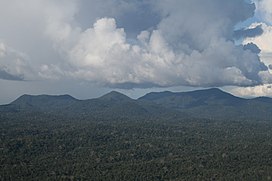
Summary
The Acarai Mountains (also, Akarai Mountains) (Portuguese: Serra do Acaraí; French: Montes Acaraí) are a wet, forested highland region of low mountains located in the southern part of Guyana. This range lies along the common border between Guyana and Brazil. The Acarai Mountains is one of four mountain ranges in Guyana, the others being the Imataka, Kanuku and Pakaraima mountains. The headwaters of the Essequibo River, the longest river in Guyana, and the Courantyne River, have their sources in this range.[1] The actual source of the Essequibo was discovered in 2013 by a Guyanese-German team.[2] The mountain range was first mentioned in 1821 by A.H. Brué as Sierra do Acaray.[1]
| Acarai Mountains | |
|---|---|
| Akarai Mountains | |
 | |
| Highest point | |
| Peak | unnamed point |
| Elevation | 1,009 m (3,310 ft) |
| Coordinates | 1°22′N 59°11′W / 1.367°N 59.183°W |
| Naming | |
| Native name | Serra do Acaraí (Portuguese) |
| Geography | |
 Acarai Mountains Location in Guyana | |
| Country | Guyana |
| Range coordinates | 1°50′N 57°30′W / 1.833°N 57.500°W |
| Borders on | Tumuk Humak Mountains |
This range is home to a single village of Wai-Wais, the descendants of surviving tribes that were once believed extinct. The village was first mentioned around 1837.[3]
The unnamed high point of this range is located at 1°22′N 59°11′W / 1.367°N 59.183°W, and has an altitude of 1,009 metres (3,310 ft). This range extends to the east, where it becomes the Tumuk Humak Mountains along the border of Suriname and French Guiana with Brazil.[1]
References edit
- ^ a b c "Encyclopaedie van Nederlandsch West-Indië - Page 24 - Akarai-gebergte". Digital Library for Dutch Literature (in Dutch). 1916. PDF. Retrieved 23 June 2020.
- ^ "Guyanese-German team discovers legendary source of the Essequibo River". Kaieteur News Online. Retrieved 22 June 2020.
- ^ "MAIN AMERINDIAN GROUPS UP TO THE NINETEENTH CENTURY". Guyana.org. Retrieved 23 June 2020.
External links edit
- The Guyana Story, Chapter 3


